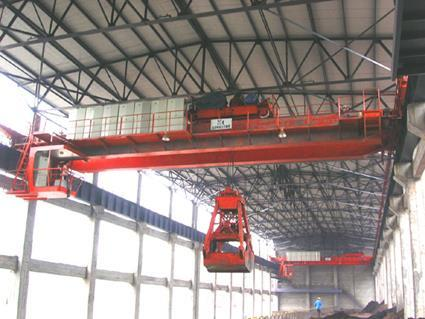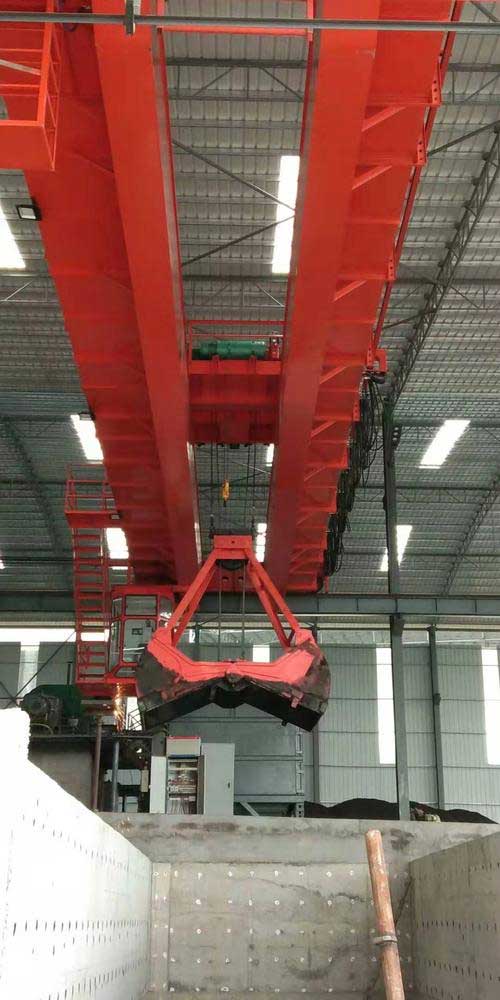The new type of crane equipment with the grab bucket as the spreader can perform operations such as unloading, stacking, reversing, retrieving, and loading materials during the raw material preparation process. With its excellent performance, the grab crane has been widely used in the hoisting of general cargo in various factories and mines, and it is equipped with a special spreader such as a grab for special operations.
In the actual operation process, in order to ensure that the grab bucket of the grab crane is full of materials, the basic conditions that should be met are suitable bucket shape, basic size, and sufficient self-weight. According to the material’s characteristics, grabs can be divided into four basic types: light, medium, heavy, and extra heavy. In comparison, the self-weight of the medium-sized grab bucket is about equal to the weight of the material, the self-weight of the light-duty grab bucket is smaller, and the self-weight of the heavy-duty grab bucket is larger. For different types of grabs, corresponding parameters and structural types should be selected. For example, double-jaw grabs are suitable for grabbing granular materials and powder materials. Toothed. When the grab is used to unload the standard-gauge vehicle, the volume of the grab is generally not more than 3 meters.
For the multi-claw grab bucket of the grab crane, the number of jaw plates in the bucket is generally 6, and the jaw plate cuts are sharp-edged. It is usually used to grab materials that are not easy to insert into the double-jaw plate grab, such as large hard pieces of ore, aluminum ingots, iron filings, scrap steel, etc.
Grab buckets can be divided into two categories: hydraulic grabs and mechanical grabs, according to the driving mode.
The hydraulic grab itself is equipped with an opening and closing structure, which is generally driven by a hydraulic cylinder. A hydraulic grab composed of multiple jaw plates is also called a hydraulic claw. Hydraulic grabs are widely used in hydraulic special equipment.
The mechanical grab itself is not equipped with an opening and closing structure. It is usually driven by the external force of a rope or a connecting rod. According to the operating characteristics, it can be divided into a double-rope grab and a single-rope grab. The most commonly used is the double-rope grab.
The double-rope grab has a support rope and an opening and closing rope, which are respectively wound on the drums of the support mechanism and the opening and closing mechanism. The double rope grab is reliable in operation, easy to operate, high in productivity, and widely used. After using two sets of double ropes, it becomes a four-rope grab, and the working process is the same as that of the double-rope grab.

For single-rope grabs, the same wire rope is used for the support rope and the opening and closing ropes. Through the special locking device, the steel wire rope plays the role of support, opening, and closing in turn. The winding mechanism of the single-rope grab is relatively simple, but the productivity is low, and it is rarely used in a large number of loading and unloading operations.
In terms of structural composition, the grab crane is mainly composed of a box-shaped bridge frame, a grab trolley, a cart running mechanism, a driver’s cab, and an electrical control system. The fetching device is a grab bucket capable of grabbing bulk materials. It includes an opening and closing mechanism and a lifting mechanism, and the grab bucket is suspended on the opening and closing mechanism and the lifting mechanism with four steel wire ropes. The opening and closing mechanisms drive the grab bucket close to grab materials. When the bucket mouth is closed, the hoisting mechanism is activated immediately so that the four steel wire ropes are evenly loaded for lifting work. When unloading, only the opening and closing mechanisms are activated, and the mouth of the bucket opens immediately to tilt the material.

Except for the difference in the lifting mechanism, the other structural components of the grab crane are basically the same as the hook bridge crane. To ensure the safety of the crane, handrails are provided. In addition, there are lighting lights under the bridge frame, insulating rubber and door switches in the driver’s room, protective covers for each transmission part, safety switches for each railing door, stoppers for the end of the stroke, and retaining hooks for the sliding wires.
So far, the applications of grab cranes include loading and unloading of bulk materials in power plants, freight yards, workshops, docks, etc. All mechanisms of the grab crane are operated in the driver’s cab, and the directions for entering the platform door of the driver’s cab are end entry, side entry, and jack entry.
Bridge cranes and gantry cranes with grab buckets are our main products; if you have any needs about them, please contact me freely, and we will provide you with professional grab bucket overhead crane and grab bucket gantry crane solutions according to your working conditions and requirements. Welcome to consult with us!